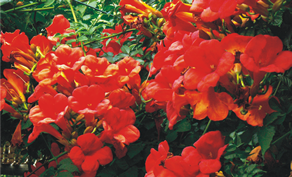|
Of the multitude of wonderful plants that we can grow here, I always feel that the climbers give us the most stunning spectacle of colour. And, of course, we have so many areas where we can use them. Remembering that most climbers can also be used as trailers or scramblers, opens up a whole new world of tumbling and soaring options! |
 |
We've lots of them in stock at the moment to cover every need – evergreen/deciduous, sun or shade
loving, big and blowsy, small and sedate, perfumed or simply fab looking – to coat white walls, drape over pergolas, hide ugly fencing, or tumble down rough banks. They can be planted at almost any time of the year so squeeze in a few more now to give you lots of summer colour and – top priority soon – shade.
I'm going to tell you about three of my favourites which are also three of the best for summer colour but we've hundreds, so come and talk to me about your particular requirements.
Petrea volubilis, Queen's Wreath, Sandpaper Vine.
From a distance this one resembles a purple wisteria with its darkly exotic flowers hanging down in 30cm racemes, each containing up to thirty individual flowers. It's a twining (volubilis) climber from Mexico and isn't too often seen here, sadly. Probably best used up a pergola where its flowers can cascade, it can also be trained into an arching mound which gives great groundcover. The dark grey/green leaves are tough and leathery, hence sandpaper vine, and contrast fabulously with the lilac/blue starry flowers which slowlyand gently fade to a soft grey. The true flower is a deep velvety violet and it sits within the lilac and narrower petal-like calyx, giving that starry effect. The main flowering is late spring into summer with a second flush in autumn. Under favourable conditions, hot with some humidity, it can carry on flowering for at least six months of the year. Slightly cold tender, it will support a degree or two of freezing and is perfectly at home with our summer temperatures. Fairly fast-growing, it will reach about 8m tall. Extremely easy, once established it is very drought tolerant and its rough leaves seem to deter most insects. Try it tumbling out of a dark green conifer – a sophisticated combination that you'll love. There is also a white form but, for me, the blue is the winner.
Campsis grandiflora, orange trumpet vine.
This is one of our most vibrantly coloured climbers, a mass of large orange or apricot trumpet flowers held in huge heads from late spring through to autumn, backed by coarsely green cut leaves. From south-east Asia, it was previously known as bignonia grandiflora, so don't worry if you see that name – it's the same plant. It's a self-clinger, by means of small aerial roots, and deciduous, so useful where you want the winter sunshine to enter. It will get huge, up to at least 10m – its trunk becoming tree-like – but you can prune it back hard every autumn. Very drought tolerant once established, it can be prone to blackfly, so keep up the applications of neem oil. If it's sheer colour with an exotic look you want, this is yours! We've some standard plants at the garden centre, trained into arching heads in a wonderful soft cantaloupe melon colour – they're stunning.
Asarina erubescens, creeping gloxinia.
This Mexican climber is, for me, a real beauty and, again, one you rarely see grown here. Its downy, fresh green, heart-shaped leaves contrast softly and perfectly with the rich burgundy trumpet flowers which coat the stems. This is a much smaller grower than the other two, up to around 4m, and it can be grown in a pot or let it form a dense twining screen on trellis. I like it close to hand, where its quiet ways will seduce you! Perennial in all but the hardest of winters, it'll go down to a degree or two under zero, and perhaps performs best with a little dappled shade.
Lorraine Cavanagh has lived in Spain for 22 years; a mother, grandmother and hispanista, her passions are plants, the environment, food and drink, and travelling within Spain. She owns a small plant nursery near Cómpeta, is a landscape gardener and a writer. She also has a weekly spot on OCI radio.
Her book Lorraine Cavanagh's Mediterranean Garden Plants has been nicknamed 'the bible'.
See also “There are No Flies ….. only Foreigners!” a social history of Andalucia and light hearted look at life in Spain.
Viveros Florena, Cómpeta.
Opening hours: Tuesday-Saturday, 10-4.
E-mail: florenaspain@hotmail.com





















